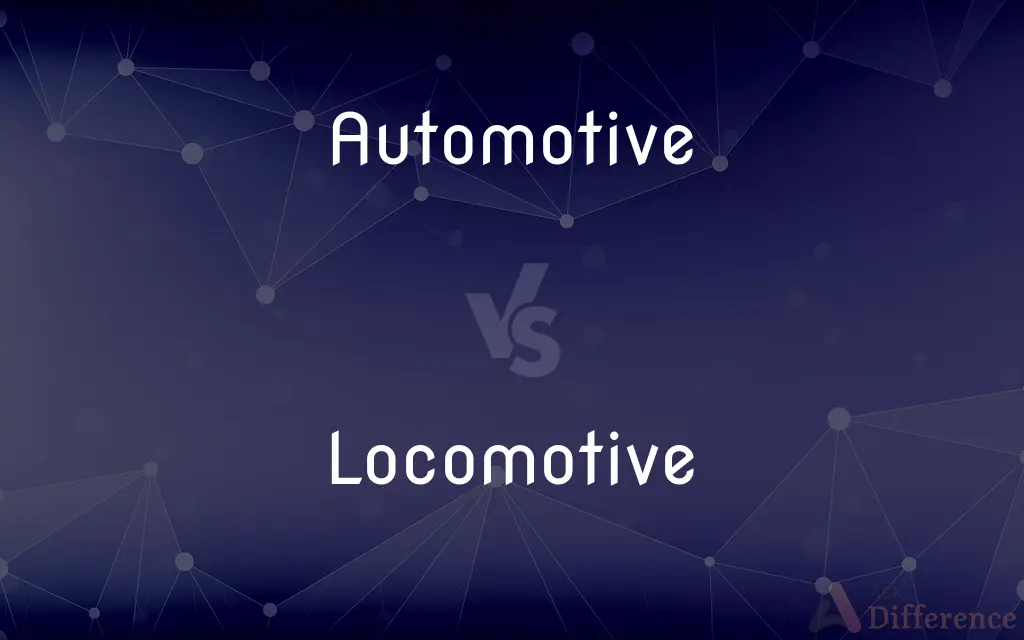Automotive vs. Locomotive — What's the Difference?
By Maham Liaqat & Fiza Rafique — Updated on March 21, 2024
Automotive refers to vehicles designed for road use, typically powered by internal combustion engines or electric motors, while locomotive refers to rail vehicles specifically designed to provide motive power for trains.

Difference Between Automotive and Locomotive
Table of Contents
ADVERTISEMENT
Key Differences
Automotive encompasses a wide range of vehicles primarily designed for transporting people and goods on roads. These can range from cars and motorcycles to buses and trucks, all of which are powered by various types of engines, including internal combustion, electric, and hybrid powertrains. On the other hand, a locomotive is a rail transport vehicle that provides the motive power for a train. Unlike automotive vehicles, locomotives are not meant to carry passengers or cargo themselves but are designed to pull or push train cars or wagons.
While automotive vehicles are a common sight in daily life, used for personal transport, business, emergency services, and more, locomotives play a crucial role in the transportation of goods and passengers over long distances. Locomotives can be powered by diesel engines, electricity obtained from overhead lines or third rails, or even steam engines, though the latter are now mostly used for heritage and tourist purposes.
Automotive technology focuses on advancements that improve safety, efficiency, and environmental friendliness, such as autonomous driving technologies, electric powertrains, and advanced driver-assistance systems (ADAS). In contrast, locomotive technology advancements often concentrate on increasing power, efficiency, and reliability to handle the heavy loads and long distances associated with rail transport, as well as improving emissions in the case of diesel locomotives.
The automotive industry is characterized by a wide range of manufacturers and brands competing in a global marketplace, offering a vast array of vehicles for various purposes and budgets. Conversely, the locomotive industry is more specialized, with fewer manufacturers that focus on the specific needs of rail transportation, including freight and passenger services.
Automotive regulations primarily focus on safety, emissions, and roadworthiness, with standards varying significantly around the world. Locomotive regulations, while also concerned with safety and emissions, are more focused on interoperability and standards that ensure trains can operate efficiently across different countries' rail networks, especially in regions like Europe.
ADVERTISEMENT
Comparison Chart
Primary Use
Road transport for people and goods
Motive power for trains
Power Source
Internal combustion, electric, hybrid
Diesel, electric, steam
Focus
Personal transport, efficiency, safety
Power, efficiency for heavy loads
Industry
Wide range of manufacturers and vehicles
Specialized manufacturers for rail transport
Regulations
Safety, emissions, roadworthiness
Safety, emissions, interoperability
Compare with Definitions
Automotive
Cars that use electric motors for propulsion, offering an environmentally friendly alternative to traditional engines.
The Tesla Model S is a leading automotive in the electric vehicle market.
Locomotive
Combine diesel engines with electric battery packs to reduce emissions and save fuel.
Hybrid locomotives represent a significant advancement in rail transport technology.
Automotive
Two-wheeled vehicles for personal transport, known for their maneuverability and fuel efficiency.
Many enthusiasts enjoy the freedom that comes with riding a motorcycle.
Locomotive
Use diesel engines to generate electricity that drives the wheels.
Modern freight trains often rely on powerful diesel locomotives.
Automotive
Vehicles with four wheels designed primarily for passenger transportation.
The Toyota Camry is a popular automotive choice for families.
Locomotive
Powered by electricity from overhead lines or third rails, known for their efficiency and lower emissions.
High-speed trains in Europe are usually powered by electric locomotives.
Automotive
Large vehicles designed to carry multiple passengers, often used for public transportation.
The city's bus service provides a reliable automotive option for commuters.
Locomotive
Specifically designed to haul freight trains, prioritizing power and durability.
The new freight locomotive can pull an impressive number of loaded wagons.
Automotive
Vehicles designed for transporting goods, varying in size from small pickups to large commercial haulers.
Trucks are essential automotive tools for the logistics industry.
Locomotive
Powered by steam engines, these were the first locomotives and are now mostly used for historic or tourist purposes.
The vintage steam locomotive attracted tourists from all over the country.
Automotive
Moving by itself; self-propelling or self-propelled.
Locomotive
A locomotive or engine is a rail transport vehicle that provides the motive power for a train. If a locomotive is capable of carrying a payload, it is usually rather referred to as a multiple unit, motor coach, railcar or power car; the use of these self-propelled vehicles is increasingly common for passenger trains, but rare for freight (see CargoSprinter and Iron Highway).
Automotive
Of or relating to self-propelled vehicles.
Locomotive
A self-propelled vehicle, usually electric, diesel, or steam-powered, for pulling or pushing freight or passenger cars on railroad tracks.
Automotive
Having the ability to move by itself; self-propelled or self-propelling.
Locomotive
A driving or pulling force; an impetus
"The US could no longer serve as the locomotive for the world economy" (George Soros).
Automotive
Of, or relating to motor vehicles.
Locomotive
Of, relating to, or involved in locomotion.
Automotive
A shop or company that sells motor vehicle parts
Locomotive
Serving to put into motion or propel forward
"It may be that the founding fathers overestimated the locomotive force of the collective and mutual self-interest" (Ian Davidson).
Automotive
Of or pertaining to the automobile.
Locomotive
Able to move independently from place to place.
Automotive
Containing within itself the means of propulsion or movement.
Locomotive
Of or relating to a self-propelled locomotive.
Automotive
Of or relating to motor vehicles;
Automotive supplies
Locomotive
Of or relating to travel.
Automotive
Containing within itself the means of propulsion or movement;
A self-propelled vehicle
Locomotive
(rail transport) The power unit of a train that pulls the coaches or wagons.
Rolling stock
Locomotive
(rare) A traction engine.
Locomotive
(slang) A cheer characterized by a slow beginning and a progressive increase in speed.
Locomotive
(archaic) Any of various early road vehicles, steam-powered, etc., forerunners of the modern car.
Locomotive
(economics) A country which drives the world economy by having a high level of imports, such as the United States.
Locomotive
Of or relating to locomotion.
Locomotive
Of or relating to the power unit of a train which does not carry passengers or freight itself.
Locomotive
Moving, or capable of motion.
Locomotive
Moving from place to place; changing place, or able to change place; as, a locomotive animal.
Locomotive
Used in producing motion; as, the locomotive organs of an animal.
Locomotive
A locomotive engine; a self-propelling wheel carriage, especially one which bears a steam boiler and one or more steam engines which communicate motion to the wheels and thus propel the carriage, - used to convey goods or passengers, or to draw wagons, railroad cars, etc. See Illustration in Appendix.
Locomotive
A wheeled vehicle consisting of a self-propelled engine that is used to draw trains along railway tracks
Locomotive
Of or relating to locomotion
Common Curiosities
Can locomotives carry passengers?
Not typically; locomotives are designed to pull passenger cars, not carry passengers themselves.
Can automotive vehicles run on rails?
Generally, no. Automotive vehicles are designed for roads, not rails, though there are specialized road-rail vehicles.
Are electric vehicles considered part of the automotive industry?
Yes, electric vehicles are a growing segment of the automotive industry.
Can automotive technology be used in locomotives?
While fundamentally different, some automotive technologies, like battery power, are being adapted for use in locomotives.
Are there autonomous locomotives?
Yes, there are autonomous locomotives, mainly used in freight and industrial applications.
How do regulations differ for automotive and locomotive industries?
Automotive regulations focus on road safety and emissions, while locomotive regulations emphasize rail safety, efficiency, and interoperability.
What is the environmental impact of locomotives vs. automotive vehicles?
Electric and hybrid locomotives have a lower environmental impact compared to diesel locomotives and automotive vehicles, especially those running on fossil fuels.
Are diesel engines still common in automotive vehicles?
Yes, but their prevalence is decreasing as electric and hybrid technologies become more popular.
What makes locomotives different from regular trains?
Locomotives are the engines that provide the motive power for trains, while "train" refers to the entire set of connected vehicles.
Are all locomotives electric?
No, locomotives can be powered by diesel, electricity, or steam, though electric and diesel are most common today.
Is high-speed rail considered locomotive or automotive?
High-speed rail is considered part of locomotive technology, as it operates on rails.
What advancements are being made in locomotive technology?
Advances include more efficient electric and hybrid engines, better emissions controls, and autonomous operation technologies.
Why are locomotives still important in the modern world?
Locomotives are crucial for efficient, long-distance transportation of goods and passengers, playing a key role in global commerce.
How has the automotive industry influenced transportation?
The automotive industry has significantly shaped personal and commercial transportation, offering mobility and flexibility.
Can locomotives be used for personal transport?
No, locomotives are designed for pulling trains, not for personal transport.
Share Your Discovery

Previous Comparison
Joy vs. Rapture
Next Comparison
Boutique vs. OutletAuthor Spotlight
Written by
Maham LiaqatCo-written by
Fiza RafiqueFiza Rafique is a skilled content writer at AskDifference.com, where she meticulously refines and enhances written pieces. Drawing from her vast editorial expertise, Fiza ensures clarity, accuracy, and precision in every article. Passionate about language, she continually seeks to elevate the quality of content for readers worldwide.
















































